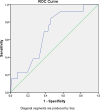Pre-earthquake kidney function is a predictor of outcomes in earthquake-related crush syndrome
- PMID: 40484930
- PMCID: PMC12147298
- DOI: 10.1186/s12882-025-04183-3
Pre-earthquake kidney function is a predictor of outcomes in earthquake-related crush syndrome
Abstract
Background: The devastating earthquakes in Kahramanmaraş, Türkiye, in February 2024, caused extensive trauma and loss of lives, causing unique challenges in the management of earthquake-related crush syndrome. The current study investigates the prognostic value of pre-earthquake kidney function for mortality prediction in patients diagnosed with crush syndrome.
Methods: A multi-center retrospective analysis was performed using data from 469 patients treated at 46 nephrology clinics. Pre-earthquake Kidney function, defined by serum creatinine and estimated glomerular filtration rate (eGFR) levels, was obtained from pre-earthquake health records. Clinical findings, laboratory parameters, complications, and survival probabilities were analyzed. Multivariate Cox regression was used to identify independent predictors of in-hospital mortality.
Results: The mean age of participants was 42.56 ± 16.92 years (Non-survivors: 50.46 ± 20.03 years, Survivors: 42.34 ± 16.80 years (p = 0.172)). The in-hospital mortality rate was 2.8%. Non-survivors exhibited significantly higher pre-earthquake creatinine levels than survivors (1.04 ± 0.61 mg/dL vs. 0.77 ± 0.33 mg/dL, p = 0.03), with lower eGFR (85.2 ± 34.7 mL/min/1.73 m² vs. 115.8 ± 39.4 mL/min/1.73 m², p = 0.008). Compared with survivors, non-survivors had higher incidences of AKI (92.3% vs. 61.6%, p = 0.037) and more severe metabolic disturbances, including hyperkalemia (5.41 ± 1.72 mmol/L vs. 5.13 ± 0.98 mmol/L, p = 0.008). Regression analysis revealed that pre-earthquake creatinine (HR: 9.121, 95% CI: 2.686-30.970, p < 0.001) and potassium levels at admission (HR: 3.338, 95% CI: 1.540-7.232, p = 0.002) were independent predictors of mortality.
Conclusions: Pre-earthquake kidney function significantly predicts mortality in crush syndrome patients, highlighting the importance of baseline kidney assessment in disaster preparedness.
Keywords: Crush syndrome; Türkiye; acute kidney injury; disaster nephrology; hyperkalemia; kidney function; mortality.
© 2025. The Author(s).
Conflict of interest statement
Declarations. Ethics approval and consent to participate: The study was conducted in accordance with the Declaration of Helsinki. The study protocol received approval from the Clinical Research Ethics Committee of Istanbul University, Istanbul Faculty of Medicine (Decision date/no: 17.02.2023/04). Written consent was not obtained with the ethics committee’s knowledge. Clinical trial number: Not applicable. Consent for publication: Not applicable. Competing interests: The authors declare no competing interests.
Figures
References
-
- Ozturk S, Tuglular S, Olmaz R, Kocyigit I. Patients with crush syndrome and kidney disease: lessons learned from the earthquake in Kahramanmaraş, Türkiye. Kidney Int. 2024;106(5):771–76. PMID: 39428169. 10.1016/j.kint.2024.08.008. - PubMed
-
- McKenna P. Earthquake engineer: earthquakes don’t kill, but buildings do. New Sci. 2011;210(2813):23. 10.1016/S0262-4079(11)61168-8. Issue,, Page, ISSN 0262-4079.
-
- Gibney RT, Sever MS, Vanholder RC. Disaster nephrology: crush injury and beyond. Kidney Int. 2014;85:1049–57. 10.1038/ki.2013.392. - PubMed
-
- Chertow GM, Lazarus JM, Christiansen CL, Cook EF, Hammermeister KE, Grover F, Daley J. Preoperative risk stratification. Circulation. 1997;95(4):878–84. 10.1161/01.cir.95.4.878. PMID: 9054745. - PubMed
-
- Sever M, Kellum J, Hoste E, Vanholder R. Application of the RIFLE criteria in patients with crush-related acute kidney injury after mass disasters. Nephrol Dial Transplant: Official Publication of the European Dialysis and Transplant Association - European Association. 2011;26(2):515–24. 10.1093/ndt/gfq426. - PubMed
Publication types
MeSH terms
Substances
LinkOut - more resources
Full Text Sources
Medical
Research Materials
Miscellaneous


